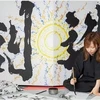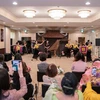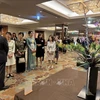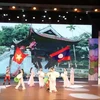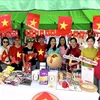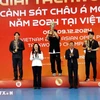It has been nearly 50 years since Nguyen Mai Hanh cut her first petals, bent the first stems and painted the first fabrics for her very first silk flowers. Now she's one of the country's most illustrious artisans.
While wafts of frying fish and dill are what lure most people to Cha Ca Street , downtown Hanoi , others are drawn simply by the
colours. The house at number 5 is full of them: they carpet the floor, climb the walls and hang from the ceiling.
The delicate, larger-than-life silk flowers that inhabit the house are made by the hands of 59-year-old Hanh, also known as the "uncrowned queen of silk flowers".
Virtually any time of day finds Hanh immersed in a bed of petals, leaves and stems, surrounded by a gaggle of teenage girl apprentices.
Hanh who was born and educated in a well-to-do family, was convinced to pursue a "feminine occupation". She tried her hand at drawing. But her teacher advised her against pursuing a career in fine art, saying there were already too many trying to make it as painters. What the country needed, he said, were craftswomen.
Hanh took his advice, and began learning the trade that her mother, Doan Thi Thai, had practised for years.
Hanh was wounded in a US bombing raid on Hanoi . During the time she lay on bed for treatment, Thai taught her to make the first petals.
"Since then, I became fascinated by silk flowers," Hanh says.
She worked hard learning to create silk flowers, unearthing a natural talent for the work. By 1986, the Government had recognised her as an official Silk Flower Craftswoman at the age 35.
Today, Hanh is known throughout Vietnam , and her work is coveted by tourists, locals and hotels and restaurants here and abroad.
While silk flowers are produced more cheaply in factories in China and Japan , what sets Hanh's apart is her use of fine materials – silks and satins from Van Phuc Village, on the outskirts Hanoi – and original designs. And every centimetre, from the stem to the petal, is hand-made.
"Many others base their designs on silk flower catalogues," Hanh said. "I usually use real flowers as models. The trick is not to make fake flowers look too beautiful."
"I want them to mimic nature, so I create ragged edges and faded colours, the way they might appear if they had actually come out of the ground."
But no matter how life-like the blooms are, one factor will always distinguish them from the original: Hanh guarantees her flowers
will continue to look freshly plucked for 10 to 15 years, even if they are washed regularly.
And Hanh's fame just can't seem to stop growing. She is proud of opportunities to bring silk flowers and teach the trade in France , Russia , Japan , Thailand , Singapore and the Republic of Korea .
Once when she introduced her products on the occasion of Hanoi Cultural Day in Toulouse , France in 2007, many visitors came to her stall but they didn't believe that her flowers were hand-made. She gave a demonstration of her skills and wowed observers.
"Some people asked to kiss my hands when they witnessed the flowers being shaped," she says.
Hanh has taught her silk flower-making secrets to domestic and foreign students alike in recent years. She stills remembers a French girl. After several years studying, she came back to her country and opened classes to teach others to make Vietnamese flowers.
"When she married, she made herself a garland of silk flowers and sent me her photos wearing it as a thank-you to me," Hanh says.
Hanh has been busier than ever of late, working around the clock to ensure visitors to the rapidly approaching 1,000th anniversary of Hanoi had a chance to catch the scent of Vietnam 's most celebrated silk florist.
"I will prepare carefully for the anniversary and be ready for whatever the Vietnam Folklore Association requests," Hanh says./.
While wafts of frying fish and dill are what lure most people to Cha Ca Street , downtown Hanoi , others are drawn simply by the
colours. The house at number 5 is full of them: they carpet the floor, climb the walls and hang from the ceiling.
The delicate, larger-than-life silk flowers that inhabit the house are made by the hands of 59-year-old Hanh, also known as the "uncrowned queen of silk flowers".
Virtually any time of day finds Hanh immersed in a bed of petals, leaves and stems, surrounded by a gaggle of teenage girl apprentices.
Hanh who was born and educated in a well-to-do family, was convinced to pursue a "feminine occupation". She tried her hand at drawing. But her teacher advised her against pursuing a career in fine art, saying there were already too many trying to make it as painters. What the country needed, he said, were craftswomen.
Hanh took his advice, and began learning the trade that her mother, Doan Thi Thai, had practised for years.
Hanh was wounded in a US bombing raid on Hanoi . During the time she lay on bed for treatment, Thai taught her to make the first petals.
"Since then, I became fascinated by silk flowers," Hanh says.
She worked hard learning to create silk flowers, unearthing a natural talent for the work. By 1986, the Government had recognised her as an official Silk Flower Craftswoman at the age 35.
Today, Hanh is known throughout Vietnam , and her work is coveted by tourists, locals and hotels and restaurants here and abroad.
While silk flowers are produced more cheaply in factories in China and Japan , what sets Hanh's apart is her use of fine materials – silks and satins from Van Phuc Village, on the outskirts Hanoi – and original designs. And every centimetre, from the stem to the petal, is hand-made.
"Many others base their designs on silk flower catalogues," Hanh said. "I usually use real flowers as models. The trick is not to make fake flowers look too beautiful."
"I want them to mimic nature, so I create ragged edges and faded colours, the way they might appear if they had actually come out of the ground."
But no matter how life-like the blooms are, one factor will always distinguish them from the original: Hanh guarantees her flowers
will continue to look freshly plucked for 10 to 15 years, even if they are washed regularly.
And Hanh's fame just can't seem to stop growing. She is proud of opportunities to bring silk flowers and teach the trade in France , Russia , Japan , Thailand , Singapore and the Republic of Korea .
Once when she introduced her products on the occasion of Hanoi Cultural Day in Toulouse , France in 2007, many visitors came to her stall but they didn't believe that her flowers were hand-made. She gave a demonstration of her skills and wowed observers.
"Some people asked to kiss my hands when they witnessed the flowers being shaped," she says.
Hanh has taught her silk flower-making secrets to domestic and foreign students alike in recent years. She stills remembers a French girl. After several years studying, she came back to her country and opened classes to teach others to make Vietnamese flowers.
"When she married, she made herself a garland of silk flowers and sent me her photos wearing it as a thank-you to me," Hanh says.
Hanh has been busier than ever of late, working around the clock to ensure visitors to the rapidly approaching 1,000th anniversary of Hanoi had a chance to catch the scent of Vietnam 's most celebrated silk florist.
"I will prepare carefully for the anniversary and be ready for whatever the Vietnam Folklore Association requests," Hanh says./.
